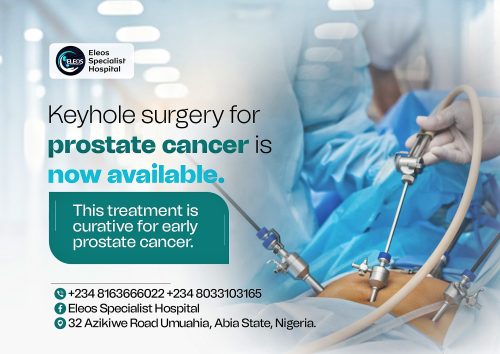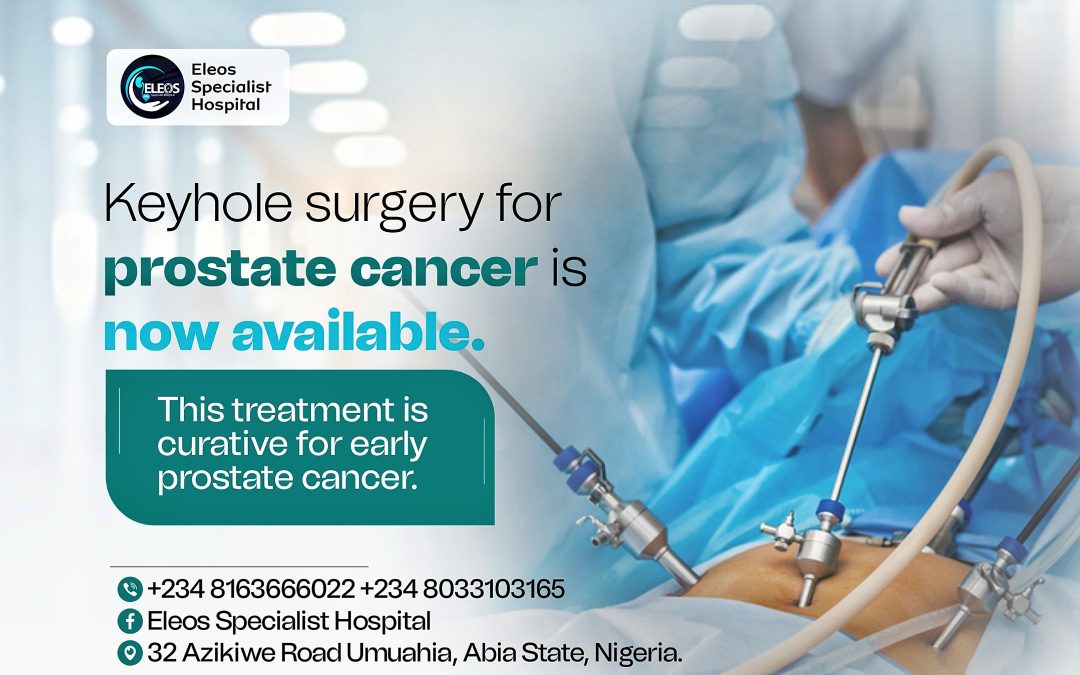So many people are curious about Prostate Cancer treatment in Nigeria. So many are curious if there are treatment options for prostate cancer in Nigeria. The purpose of this blog post is to inform you that there are treatment options.
There are various options available for Prostate Cancer treatment in Nigeria.
When a diagnosis of prostate cancer is made usually following a prostate needle biopsy, one of the first things that is usually done is to do some investigations to determine the stage of the cancer.
One of the most important investigation at this point is usually Magnetic Resonance Imaging(MRI) of the pelvis. Other investigations that can help in staging of the prostate cancer include a Bone scan or a PSMA PET Scan.
In Exploring options for Prostate Cancer treatment in Nigeria, knowing the stage of the disease is very important. The treatment options varies from one stage to another.
The aim of treatment in stage 1 and 2 prostate cancer is to cure the patient of the prostate cancer. While the aim of treatment for a patience in stage 3 and 4 prostate cancer will be to reduce or prevent a further spread of the cancer. Especially, if the cancer is already in late stage 3 or 4.

prostate cancer treatment options that patients with different stages of prostate cancer qualify for.
prostate cancer treatment in Nigeria Stage 1
The treatment options available for patients with stage 1 Prostate cancer in Nigeria includes;
Radical prostatectomy ( either open or laparoscopic ie keyhole surgery)
In Exploring Prostate Cancer treatment in Nigeria lets first look at Radical Prostatectomy
What is Prostatectomy
A prostatectomy is a surgical procedure in which the prostate is removed, either completely or partially. It can be used to treat benign prostatic hyperplasia or prostate cancer.
Making a surgical incision and excising the prostate gland (or a portion of it) is a common surgical procedure for prostatectomy.
A perineum incision (through the skin between the scrotum and the rectum) or a retropubic or suprapubic incision (lower abdomen) can be used to achieve this.
A prostate biopsy is frequently required prior to a prostatectomy.
There are several methods of radical prostatectomy:
Retropubic (suprapubic) technique for radical prostatectomy. Urologists, or physicians who specialize in disorders and surgeries of the urinary tract, most frequently employ this surgical technique.
The physician will remove lymph nodes surrounding the prostate gland in addition to the prostate itself if there is cause for concern that the cancer has spread to the lymph nodes.
If cancer is detected in the lymph nodes, it has spread outside of the prostate gland. Surgery might be stopped if that is the case because it won’t effectively treat the cancer. Other treatments might be applied in this case.
Nerve-sparing prostatectomy approach: It might not be possible to preserve the structure or function of the nerves if the cancer is entangled with them. Sometimes removing the cancerous tissue requires cutting nerves.
The man won’t be able to get an erection if both sides of the nerves are cut or removed. Even though there are treatments that could help erectile function return, this won’t get better over time.
A man may have less erectile function but may still have some function if only one side of the nerve bundle is cut or removed.
Function might continue to be normal if neither nerve bundle is affected during surgery. Nevertheless, it can occasionally take months following surgery to determine whether a full recovery is anticipated.
This is due to the fact that nerves are treated during surgery and may not be able to function normally for some time following the procedure.
Laparoscopic radical prostatectomy: Long, thin instruments are inserted inside the numerous tiny incisions the surgeon makes.
Through some of the incisions, the surgeon inserts a thin tube that contains a laparoscope, a video camera. During the procedure, this aids the surgeon’s ability to see inside.
Robotic-assisted laparoscopic prostatectomy: Robotic systems are sometimes used to perform laparoscopic surgery.
Sitting at a computer monitor close to the operating table, the surgeon manipulates the robotic arm. This process calls for specialized tools and instruction.
In Exploring Prostate Cancer treatment in Nigeria let us now look at Radical Radiotherapy ( either external beam therapy or brachytherapy)
You may also want to read PROSTATE CANCER SURGERY IN NIGERIA
What is Radical Radiotherapy
Prostate cancer can also be treated with radical radiotherapy. It works well as a substitute for surgery and is appropriate for men of all ages.
Radiation therapy is used to kill prostate cancer cells and prevent their growth. The various forms of radiation therapy and their possible adverse effects are discussed here;
External Beam Radiotherapy
High-energy X-ray beams are directed at the prostate gland and the tissues surrounding it in external beam radiotherapy, which is used to treat prostate cancer.
X-rays harm cells and prevent them from proliferating. The cells in the normal tissues surrounding the prostate (the bladder and bowel) can heal themselves more readily than cancer cells, which cannot recover from this damage.
It can be used to increase the effectiveness of chemotherapy, neo-adjuvant radiotherapy, or adjuvant radiotherapy, which is administered before surgery or after surgery.
Brachytherapy:
This form of radiotherapy can be given in two important ways:
low-dose-rate (LDR) permanent seed brachytherapy and high-dose-rate rate (HDR) temporary brachytherapy.
Low-dose-rate (LDR) permanent seed brachytherapy: This treatment, which uses radioactive seeds, works well for some men with early-stage prostate cancer.
Additionally, some immediate or high-risk patients may benefit from it. Before beginning treatment, you will undergo a thorough evaluation to ensure that your prostate is not too large. If it is, this procedure may result in problems urinating.
The seeds are inserted into the prostate through the perineum’s (the region between the scrotum and anus) skin. For this procedure, an anesthetic is required.
In order to treat prostate cancer, the needles are removed and the seeds are left inside the prostate permanently, where they gradually lose their radioactivity over time.
You are not radioactive, but the seeds are. Because the seeds contain very little radiation, you might be advised to stay away from pregnant women and small children for at least two months following the procedure as a precaution.
For some men who are unable to visit a radiotherapy center on a daily basis, this treatment may be a quicker option.
The side effects of this treatment are comparable to those of external beam radiation; however, brachytherapy carries a slightly higher risk of urinary issues and a slightly lower risk of bowel issues.
High-dose-rate (HDR) temporary brachytherapy: For men with locally advanced or high-risk prostate cancer, this treatment can be used in conjunction with external beam therapy to enable a higher radiation dose to be administered to the prostate and surrounding tissues.
Through the skin of the perineum, which is the region between the scrotum and the anus, hollow rods or needles are inserted into the prostate.
For this procedure, an anesthetic is required. Following the insertion of the needles, you will undergo a CT or ultrasound scan to determine their precise location.
Your physician and a physicist will then utilize this information to plan your course of treatment.
Cryotherapy
What is cryotherapy?
During cryotherapy, your doctor uses extremely cold temperatures to freeze and kill damaged tissue. Your healthcare provider will use argon gas or liquid nitrogen to induce this severe cold.
Numerous skin disorders as well as certain cancers, such as liver and prostate cancer, can be treated with cryotherapy. Both internal (inside the body) and external (on the skin) tissue can be treated with this therapy.
Another name for this procedure is cryoablation.
In looking at Prostate Cancer treatment in Nigeria we want to look at treatment options available.
prostate cancer treatment in Nigeria Stage 2
In looking at Prostate Cancer treatment in Nigeria we want to look at treatment options available for stage 2. The treatment options available for patients with stage 2 prostate cancer include;
Radical prostatectomy ( either open or laparoscopic ie keyhole surgery): A prostatectomy is a surgical procedure in which the prostate is removed, either completely or partially. It can be used to treat benign prostatic hyperplasia or prostate cancer.
Radical Radiotherapy ( either external beam therapy or brachytherapy): Radiation therapy is used to kill prostate cancer cells and prevent their growth.
Cryotherapy: Doctor uses extremely cold temperatures to freeze and kill damaged tissue. Your healthcare provider will use argon gas or liquid nitrogen to induce this severe cold
prostate cancer treatment in Nigeria Stage 3
The treatment options available for patients with stage 3 disease When it comes to Prostate Cancer treatment in Nigeria. These options are;
Radical prostatectomy with hormonal therapy
Radical Radiotherapy with hormonal therapy
Radical prostatectomy with radiotherapy to the prostatic bed.
Hormonal therapy alone (Surgical or Medical Castration with the use of antiandrogens)
Stage 4: The treatment options available for Prostate Cancer treatment in Nigeria include
Hormonal therapy(Surgical or Medical Castration with the use of antiandrogens)
Second line Hormonal therapy ( Where above therapy has failed)
Chemotherapy ( Where second line therapy has failed)
Adjunts to these therapies for stage 4 include Bisphosphonates, hematinics, analgesics,, focal radiotherapy as indicated.
Most of these treatment options including laparoscopic radical prostatectomy which is curative in early prostate cancer. It is available @ Eleos Specialist Hospital, Umuahia, Abia State, Nigeria.


Recent Comments